Which Component Of A Chemical Reaction Does Not Change From Beginning To End?
Chapter four: Introduction to How Cells Obtain Energy
four.1 Free energy and Metabolism
Learning Objectives
By the end of this section, you will be able to:
- Explain what metabolic pathways are
- State the first and 2nd laws of thermodynamics
- Explain the difference between kinetic and potential energy
- Describe endergonic and exergonic reactions
- Discuss how enzymes function equally molecular catalysts
Watch a video well-nigh heterotrophs.
Scientists utilize the term bioenergetics to describe the concept of free energy flow (Figure 4.ii) through living systems, such every bit cells. Cellular processes such as the building and breaking downwards of circuitous molecules occur through stepwise chemical reactions. Some of these chemic reactions are spontaneous and release free energy, whereas others require energy to proceed. Merely as living things must continually eat nutrient to furnish their energy supplies, cells must continually produce more than free energy to replenish that used by the many energy-requiring chemical reactions that constantly take place. Together, all of the chemical reactions that take place within cells, including those that eat or generate energy, are referred to as the cell'southward metabolism.
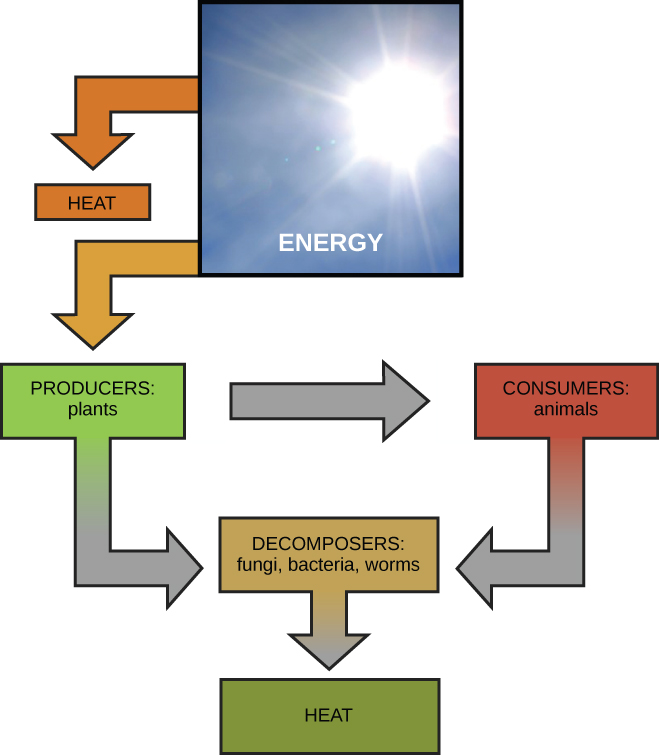
Metabolic Pathways
Consider the metabolism of sugar. This is a classic example of 1 of the many cellular processes that utilize and produce free energy. Living things consume sugars every bit a major energy source, because sugar molecules take a great deal of free energy stored within their bonds. For the most part, photosynthesizing organisms like plants produce these sugars. During photosynthesis, plants use energy (originally from sunlight) to convert carbon dioxide gas (COii) into sugar molecules (like glucose: C6H12O6). They consume carbon dioxide and produce oxygen equally a waste. This reaction is summarized as:
6CO2 + 6H2O + energy ——-> C6H12Osix+ 6O2
Because this procedure involves synthesizing an free energy-storing molecule, it requires energy input to proceed. During the calorie-free reactions of photosynthesis, energy is provided past a molecule called adenosine triphosphate (ATP), which is the primary energy currency of all cells. Just equally the dollar is used as currency to buy goods, cells utilise molecules of ATP equally free energy currency to perform immediate work. In contrast, free energy-storage molecules such as glucose are consumed simply to be broken downward to use their free energy. The reaction that harvests the energy of a saccharide molecule in cells requiring oxygen to survive can be summarized by the reverse reaction to photosynthesis. In this reaction, oxygen is consumed and carbon dioxide is released as a waste product. The reaction is summarized every bit:
CviH12Ohalf dozen + 6O2 ——> 6COii + 6HtwoO + free energy
Both of these reactions involve many steps.
The processes of making and breaking downwards sugar molecules illustrate ii examples of metabolic pathways. A metabolic pathway is a series of chemical reactions that takes a starting molecule and modifies it, footstep-by-pace, through a series of metabolic intermediates, somewhen yielding a last product. In the case of sugar metabolism, the first metabolic pathway synthesized carbohydrate from smaller molecules, and the other pathway bankrupt sugar down into smaller molecules. These two contrary processes—the offset requiring free energy and the 2nd producing free energy—are referred to as anabolic pathways (building polymers) and catabolic pathways (breaking down polymers into their monomers), respectively. Consequently, metabolism is composed of synthesis (anabolism) and degradation (catabolism) (Figure iv.3).
It is important to know that the chemical reactions of metabolic pathways do not have place on their own. Each reaction pace is facilitated, or catalyzed, by a protein called an enzyme. Enzymes are of import for catalyzing all types of biological reactions—those that require energy as well as those that release energy.

Energy
Thermodynamics refers to the study of energy and energy transfer involving concrete matter. The affair relevant to a item example of free energy transfer is called a organisation, and everything outside of that matter is called the environs. For instance, when heating a pot of water on the stove, the system includes the stove, the pot, and the water. Free energy is transferred within the system (between the stove, pot, and h2o). There are ii types of systems: open and closed. In an open system, energy can be exchanged with its surroundings. The stovetop system is open up because heat can be lost to the air. A airtight organisation cannot commutation energy with its surroundings.
Biological organisms are open systems. Free energy is exchanged betwixt them and their surroundings as they employ energy from the dominicus to perform photosynthesis or consume energy-storing molecules and release energy to the environment by doing work and releasing heat. Similar all things in the concrete earth, energy is subject to physical laws. The laws of thermodynamics govern the transfer of energy in and among all systems in the universe.
In full general, energy is defined as the ability to practice piece of work, or to create some kind of change. Energy exists in different forms. For example, electrical energy, light energy, and oestrus energy are all different types of energy. To capeesh the style energy flows into and out of biological systems, information technology is important to understand two of the physical laws that govern free energy.
Thermodynamics
The outset police of thermodynamics states that the total amount of energy in the universe is abiding and conserved. In other words, in that location has ever been, and always volition exist, exactly the same amount of energy in the universe. Energy exists in many unlike forms. According to the beginning police force of thermodynamics, energy may be transferred from place to identify or transformed into different forms, but it cannot exist created or destroyed. The transfers and transformations of free energy take identify effectually us all the time. Calorie-free bulbs transform electrical energy into lite and oestrus energy. Gas stoves transform chemic free energy from natural gas into heat energy. Plants perform i of the most biologically useful energy transformations on globe: that of converting the energy of sunlight to chemical energy stored within organic molecules (Figure iv.2). Some examples of energy transformations are shown in Figure iv.four.
The challenge for all living organisms is to obtain free energy from their surroundings in forms that they can transfer or transform into usable free energy to do work. Living cells have evolved to meet this challenge. Chemical energy stored inside organic molecules such as sugars and fats is transferred and transformed through a series of cellular chemical reactions into energy within molecules of ATP. Energy in ATP molecules is easily attainable to practice work. Examples of the types of piece of work that cells need to practice include building complex molecules, transporting materials, powering the motility of cilia or flagella, and contracting muscle fibers to create motility.
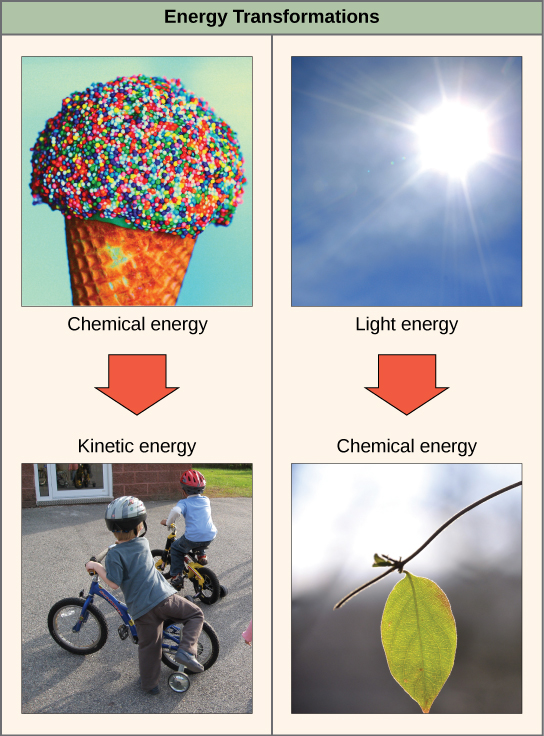
A living jail cell's primary tasks of obtaining, transforming, and using energy to practise work may seem simple. Withal, the second law of thermodynamics explains why these tasks are harder than they announced. All energy transfers and transformations are never completely efficient. In every energy transfer, some corporeality of energy is lost in a course that is unusable. In virtually cases, this form is rut free energy. Thermodynamically, heat free energy is defined equally the free energy transferred from one system to some other that is not work. For example, when a light seedling is turned on, some of the energy being converted from electric free energy into lite energy is lost every bit heat energy. Likewise, some energy is lost as heat energy during cellular metabolic reactions.
An of import concept in physical systems is that of gild and disorder. The more free energy that is lost by a arrangement to its environs, the less ordered and more than random the arrangement is. Scientists refer to the measure out of randomness or disorder within a organisation every bit entropy. High entropy means high disorder and low energy. Molecules and chemical reactions have varying entropy as well. For example, entropy increases as molecules at a high concentration in one place lengthened and spread out. The 2nd police force of thermodynamics says that free energy will ever be lost as estrus in free energy transfers or transformations.
Living things are highly ordered, requiring constant energy input to be maintained in a state of depression entropy.
Potential and Kinetic Energy
When an object is in motion, there is free energy associated with that object. Think of a wrecking ball. Even a irksome-moving wrecking ball can do a great deal of damage to other objects. Energy associated with objects in motion is chosen kinetic energy (Figure iv.5). A speeding bullet, a walking person, and the rapid movement of molecules in the air (which produces estrus) all have kinetic energy.
Now what if that aforementioned motionless wrecking ball is lifted two stories higher up ground with a crane? If the suspended wrecking brawl is unmoving, is at that place free energy associated with it? The respond is yes. The energy that was required to elevator the wrecking ball did non disappear, simply is at present stored in the wrecking ball by virtue of its position and the strength of gravity acting on it. This type of energy is chosen potential energy (Figure four.5). If the ball were to fall, the potential energy would be transformed into kinetic energy until all of the potential energy was exhausted when the ball rested on the basis. Wrecking balls likewise swing like a pendulum; through the swing, at that place is a abiding change of potential energy (highest at the top of the swing) to kinetic energy (highest at the bottom of the swing). Other examples of potential energy include the energy of water held backside a dam or a person about to skydive out of an plane.

Potential energy is not only associated with the location of matter, but also with the structure of matter. Even a bound on the ground has potential energy if it is compressed; then does a safety ring that is pulled taut. On a molecular level, the bonds that hold the atoms of molecules together be in a particular construction that has potential energy. Remember that anabolic cellular pathways require energy to synthesize circuitous molecules from simpler ones and catabolic pathways release free energy when circuitous molecules are broken down. The fact that energy tin can be released by the breakdown of certain chemical bonds implies that those bonds take potential free energy. In fact, there is potential energy stored inside the bonds of all the nutrient molecules we consume, which is somewhen harnessed for apply. This is because these bonds can release energy when broken. The type of potential energy that exists within chemical bonds, and is released when those bonds are broken, is called chemical energy. Chemical energy is responsible for providing living cells with energy from food. The release of energy occurs when the molecular bonds within nutrient molecules are broken.
Watch a video near kilocalories.
Concept in Action

Visit the site and select "Pendulum" from the "Piece of work and Energy" menu to encounter the shifting kinetic and potential energy of a pendulum in move.
Free and Activation Energy
After learning that chemical reactions release energy when energy-storing bonds are broken, an important next question is the following: How is the energy associated with these chemical reactions quantified and expressed? How can the energy released from one reaction be compared to that of some other reaction? A measurement of costless energy is used to quantify these energy transfers. Recall that according to the second constabulary of thermodynamics, all energy transfers involve the loss of some amount of energy in an unusable form such as oestrus. Free energy specifically refers to the energy associated with a chemical reaction that is available subsequently the losses are accounted for. In other words, free free energy is usable energy, or energy that is available to do work.
If energy is released during a chemical reaction, and so the change in free free energy, signified as ∆G (delta G) will be a negative number. A negative change in energy also means that the products of the reaction have less gratuitous energy than the reactants, because they release some gratis energy during the reaction. Reactions that have a negative change in free energy and consequently release free energy are called exergonic reactions. Think: exergonic means free energy is exiting the organization. These reactions are also referred to as spontaneous reactions, and their products have less stored free energy than the reactants. An important distinction must exist drawn between the term spontaneous and the idea of a chemical reaction occurring immediately. Contrary to the everyday use of the term, a spontaneous reaction is not one that suddenly or quickly occurs. The rusting of fe is an example of a spontaneous reaction that occurs slowly, trivial by little, over time.
If a chemical reaction absorbs energy rather than releases energy on residual, then the ∆G for that reaction will be a positive value. In this case, the products have more energy than the reactants. Thus, the products of these reactions can be thought of as energy-storing molecules. These chemical reactions are chosen endergonic reactions and they are non-spontaneous. An endergonic reaction will not accept place on its own without the addition of gratis free energy.
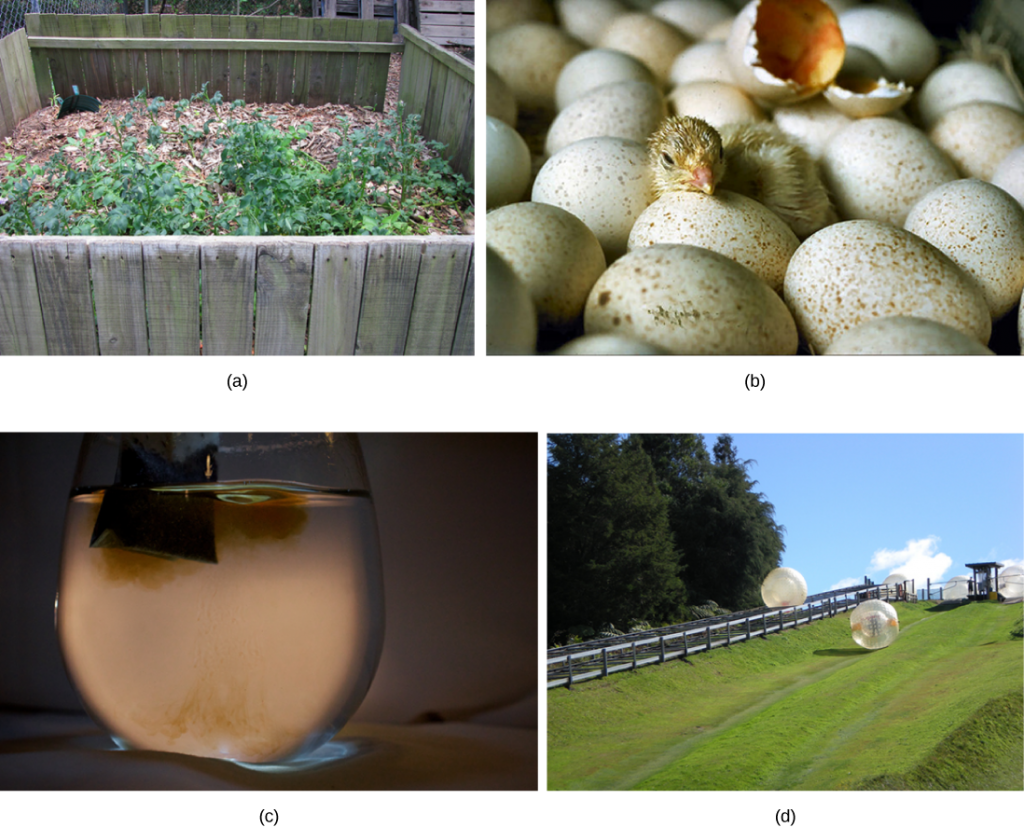
Expect at each of the processes shown and decide if it is endergonic or exergonic.
There is another important concept that must be considered regarding endergonic and exergonic reactions. Exergonic reactions crave a small amount of energy input to get going, earlier they can go on with their energy-releasing steps. These reactions accept a internet release of energy, just still require some energy input in the beginning. This pocket-sized amount of energy input necessary for all chemical reactions to occur is called the activation energy.
Concept in Action

Watch an blitheness of the movement from free energy to transition state of the reaction.
Enzymes
A substance that helps a chemical reaction to occur is called a catalyst, and the molecules that catalyze biochemical reactions are called enzymes. Well-nigh enzymes are proteins and perform the disquisitional chore of lowering the activation energies of chemical reactions within the cell. Well-nigh of the reactions critical to a living prison cell happen as well slowly at normal temperatures to exist of whatsoever use to the prison cell. Without enzymes to speed up these reactions, life could not persist. Enzymes practise this by binding to the reactant molecules and holding them in such a manner as to make the chemical bond-breaking and -forming processes take place more hands. It is important to think that enzymes do non change whether a reaction is exergonic (spontaneous) or endergonic. This is because they practice non alter the energy of the reactants or products. They only reduce the activation energy required for the reaction to go forward (Figure four.vii). In addition, an enzyme itself is unchanged by the reaction it catalyzes. Once 1 reaction has been catalyzed, the enzyme is able to participate in other reactions.
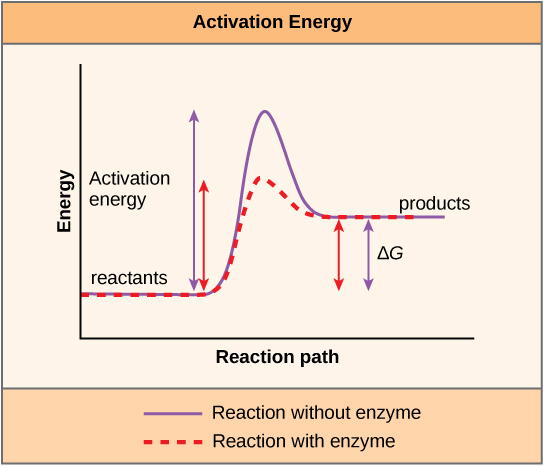
The chemical reactants to which an enzyme binds are called the enzyme's substrates. At that place may be one or more substrates, depending on the particular chemical reaction. In some reactions, a single reactant substrate is broken down into multiple products. In others, two substrates may come together to create one larger molecule. 2 reactants might likewise enter a reaction and both become modified, but they leave the reaction as ii products. The location within the enzyme where the substrate binds is called the enzyme'south active site. The active site is where the "action" happens. Since enzymes are proteins, there is a unique combination of amino acid side chains within the active site. Each side chain is characterized by different backdrop. They tin can be large or small, weakly acidic or basic, hydrophilic or hydrophobic, positively or negatively charged, or neutral. The unique combination of side chains creates a very specific chemical environment within the agile site. This specific environment is suited to bind to one specific chemical substrate (or substrates).
Active sites are subject to influences of the local surroundings. Increasing the environmental temperature generally increases reaction rates, enzyme-catalyzed or otherwise. Nonetheless, temperatures exterior of an optimal range reduce the rate at which an enzyme catalyzes a reaction. Hot temperatures will eventually crusade enzymes to denature, an irreversible change in the three-dimensional shape and therefore the function of the enzyme. Enzymes are likewise suited to function all-time within a certain pH and salt concentration range, and, equally with temperature, extreme pH, and common salt concentrations can cause enzymes to denature.
For many years, scientists thought that enzyme-substrate binding took identify in a simple "lock and central" fashion. This model asserted that the enzyme and substrate fit together perfectly in one instantaneous pace. Notwithstanding, current research supports a model called induced fit (Figure 4.eight). The induced-fit model expands on the lock-and-key model by describing a more dynamic binding between enzyme and substrate. As the enzyme and substrate come together, their interaction causes a mild shift in the enzyme'south structure that forms an ideal binding system betwixt enzyme and substrate.
Concept in Action

View an blitheness of induced fit.
When an enzyme binds its substrate, an enzyme-substrate complex is formed. This complex lowers the activation energy of the reaction and promotes its rapid progression in one of multiple possible ways. On a basic level, enzymes promote chemical reactions that involve more than one substrate past bringing the substrates together in an optimal orientation for reaction. Another way in which enzymes promote the reaction of their substrates is by creating an optimal environment within the active site for the reaction to occur. The chemical properties that emerge from the particular arrangement of amino acrid R groups within an active site create the perfect environment for an enzyme'southward specific substrates to react.
The enzyme-substrate complex tin can likewise lower activation free energy past compromising the bond construction so that it is easier to suspension. Finally, enzymes can also lower activation energies by taking part in the chemical reaction itself. In these cases, it is important to remember that the enzyme will ever render to its original state past the completion of the reaction. One of the authentication properties of enzymes is that they remain ultimately unchanged by the reactions they catalyze. Subsequently an enzyme has catalyzed a reaction, it releases its production(south) and can catalyze a new reaction.
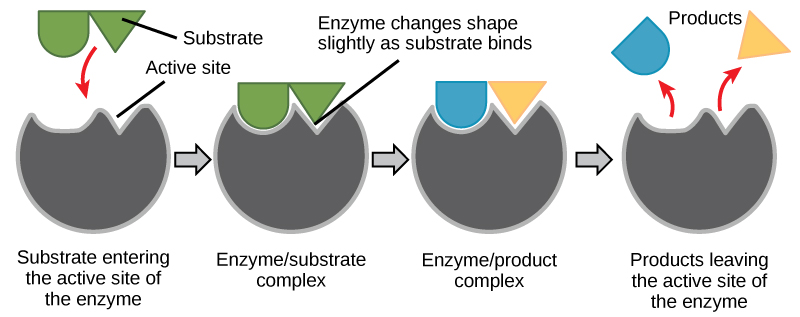
It would seem ideal to take a scenario in which all of an organism's enzymes existed in abundant supply and functioned optimally under all cellular conditions, in all cells, at all times. Even so, a diverseness of mechanisms ensures that this does not happen. Cellular needs and conditions constantly vary from cell to prison cell, and change inside individual cells over fourth dimension. The required enzymes of stomach cells differ from those of fat storage cells, skin cells, blood cells, and nerve cells. Furthermore, a digestive organ cell works much harder to procedure and break downward nutrients during the time that closely follows a meal compared with many hours after a meal. Every bit these cellular demands and weather vary, so must the amounts and functionality of unlike enzymes.
Since the rates of biochemical reactions are controlled by activation free energy, and enzymes lower and decide activation energies for chemical reactions, the relative amounts and functioning of the variety of enzymes within a prison cell ultimately make up one's mind which reactions will go on and at what rates. This determination is tightly controlled in cells. In certain cellular environments, enzyme activity is partly controlled past environmental factors like pH, temperature, salt concentration, and, in some cases, cofactors or coenzymes.
Enzymes can too be regulated in means that either promote or reduce enzyme activity. There are many kinds of molecules that inhibit or promote enzyme function, and diverse mechanisms by which they do so. In some cases of enzyme inhibition, an inhibitor molecule is similar enough to a substrate that it can bind to the agile site and only block the substrate from binding. When this happens, the enzyme is inhibited through competitive inhibition, because an inhibitor molecule competes with the substrate for binding to the active site.
On the other mitt, in noncompetitive inhibition, an inhibitor molecule binds to the enzyme in a location other than the active site, called an allosteric site, just still manages to block substrate binding to the active site. Some inhibitor molecules bind to enzymes in a location where their bounden induces a conformational change that reduces the affinity of the enzyme for its substrate. This type of inhibition is called allosteric inhibition (Figure 4.9). Most allosterically regulated enzymes are made upward of more than ane polypeptide, meaning that they have more than one protein subunit. When an allosteric inhibitor binds to a region on an enzyme, all agile sites on the poly peptide subunits are changed slightly such that they bind their substrates with less efficiency. At that place are allosteric activators besides as inhibitors. Allosteric activators demark to locations on an enzyme abroad from the active site, inducing a conformational change that increases the affinity of the enzyme'south active site(south) for its substrate(s) (Effigy 4.9).
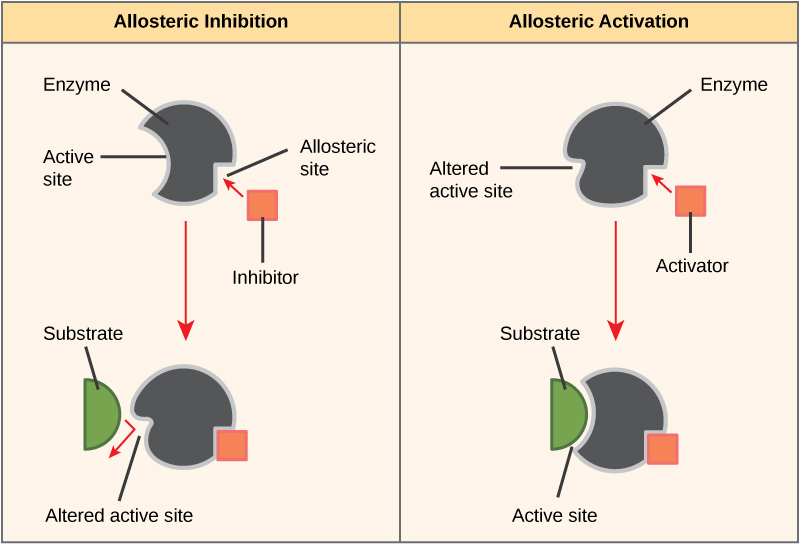
Through the Ethnic Lens
Plants cannot run or hibernate from their predators and have evolved many strategies to deter those who would eat them. Remember of thorns, irritants and secondary metabolites: these are compounds that do not direct assist the plant grow, just are made specifically to keep predators away. Secondary metabolites are the most mutual way plants deter predators. Some examples of secondary metabolites are atropine, nicotine, THC and caffeine. Humans have found these secondary metabolite compounds a rich source of materials for medicines. Information technology is estimated that 90% of the drugs in the modern pharmacy accept their "roots" in these secondary metabolites.
First peoples herbal treatments revealed these secondary metabolites to the world. For instance, Indigenous peoples have long used the bawl of willow shrubs and alder copse for a tea, tonic or poultice to reduce inflammation. You will learn more about the inflammation response by the allowed system in affiliate eleven.
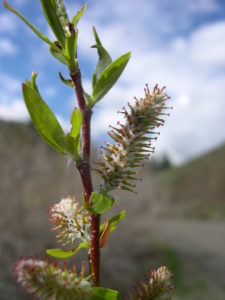
Both willow and alder bawl contain the compound salicin. Most of us take this compound in our medicine cupboard in the form of salicylic acrid or aspirin. Aspirin has been proved to reduce pain and inflammation, and once in our cells salicin converts to salicylic acid.
So how does information technology work? Salicin or aspirin acts as an enzyme inhibitor. In the inflammatory response two enzymes, COX1 and COX2 are primal to this process. Salicin or aspirin specifically modifies an amino acrid (serine) in the active site of these two related enzymes. This modification of the active sites does not let the normal substrate to bind and so the inflammatory procedure is disrupted. As you take read in this chapter, this makes information technology competitive enzyme inhibitor.
Pharmaceutical Drug Developer
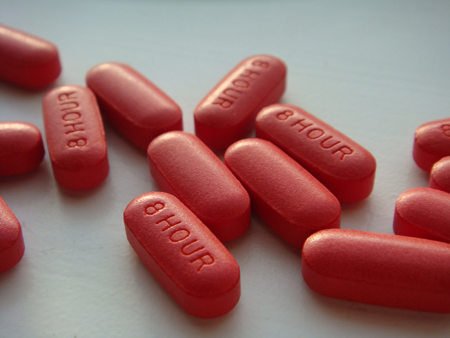
Enzymes are key components of metabolic pathways. Understanding how enzymes work and how they can exist regulated are key principles behind the development of many of the pharmaceutical drugs on the market today. Biologists working in this field collaborate with other scientists to design drugs (Figure 4.11).
Consider statins for case—statins is the name given to one class of drugs that tin reduce cholesterol levels. These compounds are inhibitors of the enzyme HMG-CoA reductase, which is the enzyme that synthesizes cholesterol from lipids in the body. By inhibiting this enzyme, the level of cholesterol synthesized in the body can be reduced. Similarly, acetaminophen, popularly marketed under the brand proper name Tylenol, is an inhibitor of the enzyme cyclooxygenase. While it is used to provide relief from fever and inflammation (pain), its mechanism of action is still not completely understood.
How are drugs discovered? One of the biggest challenges in drug discovery is identifying a drug target. A drug target is a molecule that is literally the target of the drug. In the example of statins, HMG-CoA reductase is the drug target. Drug targets are identified through painstaking inquiry in the laboratory. Identifying the target alone is not enough; scientists also demand to know how the target acts inside the jail cell and which reactions become awry in the case of illness. One time the target and the pathway are identified, then the actual process of drug pattern begins. In this stage, chemists and biologists work together to design and synthesize molecules that tin can cake or actuate a item reaction. However, this is but the beginning: If and when a drug prototype is successful in performing its function, then information technology is subjected to many tests from in vitro experiments to clinical trials before it can go blessing from the U.South. Nutrient and Drug Administration to exist on the market.
Many enzymes do non work optimally, or even at all, unless leap to other specific non-protein helper molecules. They may bond either temporarily through ionic or hydrogen bonds, or permanently through stronger covalent bonds. Binding to these molecules promotes optimal shape and part of their respective enzymes. Two examples of these types of helper molecules are cofactors and coenzymes. Cofactors are inorganic ions such equally ions of atomic number 26 and magnesium. Coenzymes are organic helper molecules, those with a basic atomic structure made up of carbon and hydrogen. Like enzymes, these molecules participate in reactions without existence changed themselves and are ultimately recycled and reused. Vitamins are the source of coenzymes. Some vitamins are the precursors of coenzymes and others act directly equally coenzymes. Vitamin C is a direct coenzyme for multiple enzymes that take office in building the important connective tissue, collagen. Therefore, enzyme role is, in part, regulated by the affluence of various cofactors and coenzymes, which may be supplied by an organism's diet or, in some cases, produced by the organism.
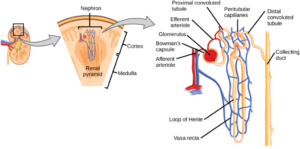
Feedback Inhibition in Metabolic Pathways
Molecules can regulate enzyme function in many ways. The major question remains, however: What are these molecules and where practise they come up from? Some are cofactors and coenzymes, as you have learned. What other molecules in the cell provide enzymatic regulation such as allosteric modulation, and competitive and non-competitive inhibition? Mayhap the nearly relevant sources of regulatory molecules, with respect to enzymatic cellular metabolism, are the products of the cellular metabolic reactions themselves. In a most efficient and elegant way, cells have evolved to use the products of their own reactions for feedback inhibition of enzyme activity. Feedback inhibition involves the use of a reaction product to regulate its own farther production (Figure 4.12). The cell responds to an abundance of the products past slowing down production during anabolic or catabolic reactions. Such reaction products may inhibit the enzymes that catalyzed their production through the mechanisms described higher up.

The production of both amino acids and nucleotides is controlled through feedback inhibition. Additionally, ATP is an allosteric regulator of some of the enzymes involved in the catabolic breakdown of sugar, the process that creates ATP. In this style, when ATP is in arable supply, the cell can prevent the production of ATP. On the other manus, ADP serves as a positive allosteric regulator (an allosteric activator) for some of the same enzymes that are inhibited by ATP. Thus, when relative levels of ADP are high compared to ATP, the cell is triggered to produce more ATP through saccharide catabolism.
Department Summary
Cells perform the functions of life through various chemical reactions. A prison cell's metabolism refers to the combination of chemical reactions that take place within information technology. Catabolic reactions break down complex chemicals into simpler ones and are associated with energy release. Anabolic processes build complex molecules out of simpler ones and crave energy.
In studying energy, the term system refers to the affair and environment involved in energy transfers. Entropy is a measure out of the disorder of a arrangement. The physical laws that depict the transfer of free energy are the laws of thermodynamics. The first law states that the total amount of energy in the universe is constant. The 2nd law of thermodynamics states that every energy transfer involves some loss of free energy in an unusable class, such every bit rut free energy. Free energy comes in different forms: kinetic, potential, and gratuitous. The modify in complimentary free energy of a reaction can be negative (releases energy, exergonic) or positive (consumes energy, endergonic). All reactions require an initial input of free energy to proceed, called the activation energy.
Enzymes are chemical catalysts that speed upwards chemical reactions by lowering their activation free energy. Enzymes have an agile site with a unique chemical environs that fits particular chemical reactants for that enzyme, called substrates. Enzymes and substrates are thought to bind according to an induced-fit model. Enzyme activeness is regulated to conserve resource and answer optimally to the surroundings.
Glossary
activation energy: the amount of initial energy necessary for reactions to occur
active site: a specific region on the enzyme where the substrate binds
allosteric inhibition: the mechanism for inhibiting enzyme action in which a regulatory molecule binds to a second site (not the active site) and initiates a conformation modify in the active site, preventing binding with the substrate
anabolic: describes the pathway that requires a internet energy input to synthesize complex molecules from simpler ones
bioenergetics: the concept of free energy flow through living systems
catabolic: describes the pathway in which complex molecules are broken down into simpler ones, yielding free energy as an additional product of the reaction
competitive inhibition: a general mechanism of enzyme activity regulation in which a molecule other than the enzyme's substrate is able to demark the active site and prevent the substrate itself from binding, thus inhibiting the overall rate of reaction for the enzyme
endergonic: describes a chemic reaction that results in products that shop more chemical potential energy than the reactants
enzyme: a molecule that catalyzes a biochemical reaction
exergonic: describes a chemical reaction that results in products with less chemic potential energy than the reactants, plus the release of costless energy
feedback inhibition: a mechanism of enzyme action regulation in which the product of a reaction or the final product of a series of sequential reactions inhibits an enzyme for an earlier step in the reaction series
heat energy: the energy transferred from one system to some other that is not work
kinetic energy: the type of energy associated with objects in motion
metabolism: all the chemical reactions that take place inside cells, including those that use energy and those that release energy
noncompetitive inhibition: a general mechanism of enzyme activeness regulation in which a regulatory molecule binds to a site other than the active site and prevents the agile site from binding the substrate; thus, the inhibitor molecule does not compete with the substrate for the active site; allosteric inhibition is a form of noncompetitive inhibition
potential energy: the type of free energy that refers to the potential to do work
substrate: a molecule on which the enzyme acts
thermodynamics: the science of the relationships between heat, energy, and piece of work
Which Component Of A Chemical Reaction Does Not Change From Beginning To End?,
Source: https://opentextbc.ca/biology/chapter/4-1-energy-and-metabolism/
Posted by: amesbeferal.blogspot.com


0 Response to "Which Component Of A Chemical Reaction Does Not Change From Beginning To End?"
Post a Comment